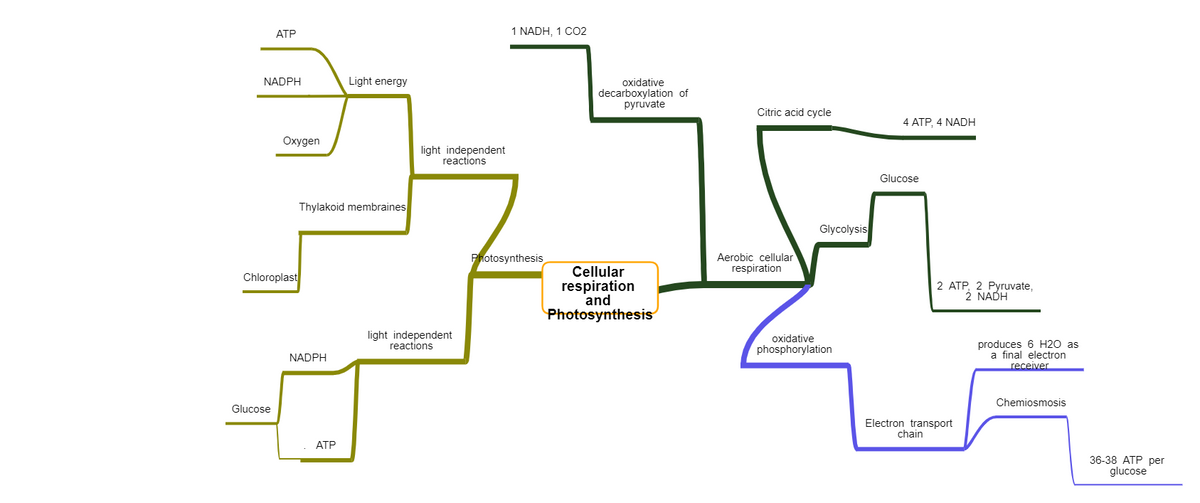First, you should map out all of the biochemical stages and processes in cellular respiration and photosynthesis. This means all of the stages are unpacked in-depth (light-dark Calvin Krebs glycolysis) into stages, their inputs (reactants), outputs (Products), and interdependent molecules (connected molecules). Add more detail to the mind map below about cellular respiration and photosynthesis. (Also added an extra image of what the level of detail should be.)
First, you should map out all of the biochemical stages and processes in cellular respiration and photosynthesis. This means all of the stages are unpacked in-depth (light-dark Calvin Krebs glycolysis) into stages, their inputs (reactants), outputs (Products), and interdependent molecules (connected molecules). Add more detail to the mind map below about cellular respiration and photosynthesis. (Also added an extra image of what the level of detail should be.)
Biochemistry
6th Edition
ISBN:9781305577206
Author:Reginald H. Garrett, Charles M. Grisham
Publisher:Reginald H. Garrett, Charles M. Grisham
Chapter21: Photosynthesis
Section: Chapter Questions
Problem 5P: The Relative Efficiency of ATP Synthesis in Noncyclic versus Cyclic Photophosphorylation If...
Related questions
Question
First, you should map out all of the biochemical stages and processes in
Add more detail to the mind map below about cellular respiration and photosynthesis. (Also added an extra image of what the level of detail should be.)

Transcribed Image Text:ates into
DP
lates into
Y
TP
used in
s down into
2 3GP(3C)
converts into
2 pyruvate (3C)
used in
2 H+
2 NAD+
reduces to
2 NADH
2 e
recieves
2 NAD+
reduces to
2 NADH
el
from 2 pyruvate (3C)
oxidizes
2 H+
decarboxylzed
to release
forms
2 CO₂
2 NADH
reduces into
2 NAD
2 H
to

Transcribed Image Text:ATP
NADPH
Oxygen
Chloroplast
Glucose
Thylakoid membraines
NADPH
Light energy
ATP
light independent
reactions
light independent
reactions
1 NADH, 1 CO2
Photosynthesis
oxidative
decarboxylation of
pyruvate
Cellular
respiration
and
Photosynthesis
Citric acid cycle
Aerobic cellular
respiration
Glycolysis
oxidative
phosphorylation
4 ATP, 4 NADH
Glucose
2 ATP, 2 Pyruvate,
2 NADH
Electron transport
chain
produces 6 H2O as
a final electron
receiver
Chemiosmosis
36-38 ATP per
glucose
Expert Solution
This question has been solved!
Explore an expertly crafted, step-by-step solution for a thorough understanding of key concepts.
Step by step
Solved in 3 steps

Knowledge Booster
Learn more about
Need a deep-dive on the concept behind this application? Look no further. Learn more about this topic, biology and related others by exploring similar questions and additional content below.Recommended textbooks for you

Biochemistry
Biochemistry
ISBN:
9781305577206
Author:
Reginald H. Garrett, Charles M. Grisham
Publisher:
Cengage Learning

Biology Today and Tomorrow without Physiology (Mi…
Biology
ISBN:
9781305117396
Author:
Cecie Starr, Christine Evers, Lisa Starr
Publisher:
Cengage Learning

Biochemistry
Biochemistry
ISBN:
9781305577206
Author:
Reginald H. Garrett, Charles M. Grisham
Publisher:
Cengage Learning

Biology Today and Tomorrow without Physiology (Mi…
Biology
ISBN:
9781305117396
Author:
Cecie Starr, Christine Evers, Lisa Starr
Publisher:
Cengage Learning